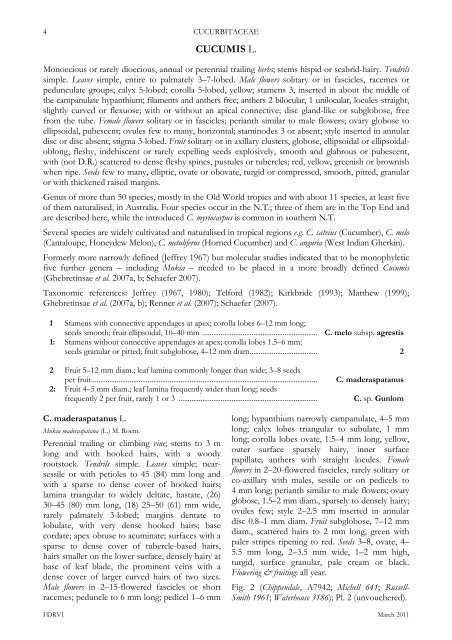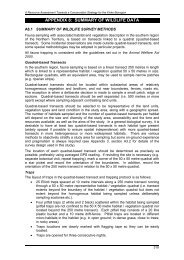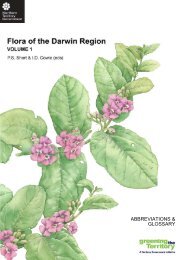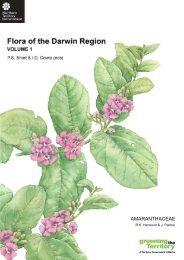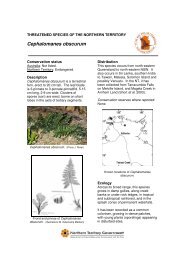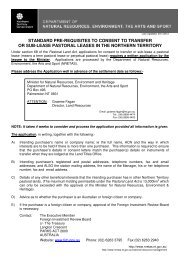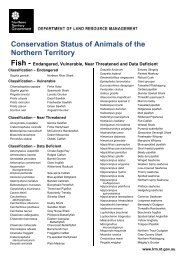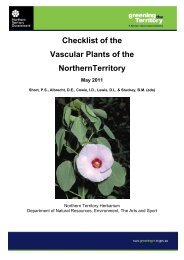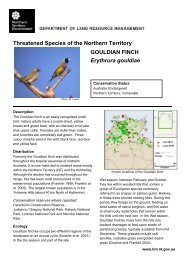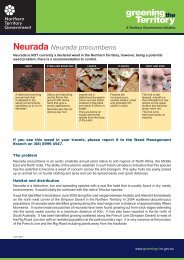CUCURBITACEAE - Department of Land Resource Management
CUCURBITACEAE - Department of Land Resource Management
CUCURBITACEAE - Department of Land Resource Management
You also want an ePaper? Increase the reach of your titles
YUMPU automatically turns print PDFs into web optimized ePapers that Google loves.
4<br />
<strong>CUCURBITACEAE</strong><br />
CUCUMIS L.<br />
Monoecious or rarely dioecious, annual or perennial trailing herbs; stems hispid or scabrid-hairy. Tendrils<br />
simple. Leaves simple, entire to palmately 3–7-lobed. Male flowers solitary or in fascicles, racemes or<br />
pedunculate groups; calyx 5-lobed; corolla 5-lobed, yellow; stamens 3, inserted in about the middle <strong>of</strong><br />
the campanulate hypanthium; filaments and anthers free; anthers 2 bilocular, 1 unilocular, locules straight,<br />
slightly curved or flexuose; with or without an apical connective; disc gland-like or subglobose, free<br />
from the tube. Female flowers solitary or in fascicles; perianth similar to male flowers; ovary globose to<br />
ellipsoidal, pubescent; ovules few to many, horizontal; staminodes 3 or absent; style inserted in annular<br />
disc or disc absent; stigma 3-lobed. Fruit solitary or in axillary clusters, globose, ellipsoidal or ellipsoidaloblong,<br />
fleshy, indehiscent or rarely expelling seeds explosively, smooth and glabrous or pubescent,<br />
with (not D.R.) scattered to dense fleshy spines, pustules or tubercles; red, yellow, greenish or brownish<br />
when ripe. Seeds few to many, elliptic, ovate or obovate, turgid or compressed, smooth, pitted, granular<br />
or with thickened raised margins.<br />
Genus <strong>of</strong> more than 50 species, mostly in the Old World tropics and with about 11 species, at least five<br />
<strong>of</strong> them naturalised, in Australia. Four species occur in the N.T.; three <strong>of</strong> them are in the Top End and<br />
are described here, while the introduced C. myriocarpus is common in southern N.T.<br />
Several species are widely cultivated and naturalised in tropical regions e.g. C. satvius (Cucumber), C. melo<br />
(Cantaloupe, Honeydew Melon), C. metuliferus (Horned Cucumber) and C. anguria (West Indian Gherkin).<br />
Formerly more narrowly defined (Jeffrey 1967) but molecular studies indicated that to be monophyletic<br />
five further genera – including Mukia – needed to be placed in a more broadly defined Cucumis<br />
(Ghebretinsae et al. 2007a, b; Schaefer 2007).<br />
Taxonomic references: Jeffrey (1967, 1980); Telford (1982); Kirkbride (1993); Matthew (1999);<br />
Ghebretinsae et al. (2007a, b); Renner et al. (2007); Schaefer (2007).<br />
1 Stamens with connective appendages at apex; corolla lobes 6–12 mm long;<br />
seeds smooth; fruit ellipsoidal, 10–40 mm ............................................................... C. melo subsp. agrestis<br />
1: Stamens without connective appendages at apex; corolla lobes 1.5–6 mm;<br />
seeds granular or pitted; fruit subglobose, 4–12 mm diam..................................... 2<br />
2 Fruit 5–12 mm diam.; leaf lamina commonly longer than wide; 3–8 seeds<br />
per fruit............................................................................................................................ C. maderaspatanus<br />
2: Fruit 4–5 mm diam.; leaf lamina frequently wider than long; seeds<br />
frequently 2 per fruit, rarely 1 or 3 ............................................................................ C. sp. Gunlom<br />
C. maderaspatanus L.<br />
Mukia maderaspatana (L.) M. Roem.<br />
Perennial trailing or climbing vine; stems to 3 m<br />
long and with hooked hairs, with a woody<br />
rootstock. Tendrils simple. Leaves simple; nearsessile<br />
or with petioles to 45 (84) mm long and<br />
with a sparse to dense cover <strong>of</strong> hooked hairs;<br />
lamina triangular to widely deltate, hastate, (26)<br />
30–45 (80) mm long, (18) 25–50 (61) mm wide,<br />
rarely palmately 3-lobed; margins dentate to<br />
lobulate, with very dense hooked hairs; base<br />
cordate; apex obtuse to acuminate; surfaces with a<br />
sparse to dense cover <strong>of</strong> tubercle-based hairs,<br />
hairs smaller on the lower surface, densely hairy at<br />
base <strong>of</strong> leaf blade, the prominent veins with a<br />
dense cover <strong>of</strong> larger curved hairs <strong>of</strong> two sizes.<br />
Male flowers in 2–15-flowered fascicles or short<br />
racemes; peduncle to 6 mm long; pedicel 1–6 mm<br />
long; hypanthium narrowly campanulate, 4–5 mm<br />
long; calyx lobes triangular to subulate, 1 mm<br />
long; corolla lobes ovate, 1.5–4 mm long, yellow,<br />
outer surface sparsely hairy, inner surface<br />
papillate; anthers with straight locules. Female<br />
flowers in 2–20-flowered fascicles, rarely solitary or<br />
co-axillary with males, sessile or on pedicels to<br />
4 mm long; perianth similar to male flowers; ovary<br />
globose, 1.5–2 mm diam., sparsely to densely hairy;<br />
ovules few; style 2–2.5 mm inserted in annular<br />
disc 0.8–1 mm diam. Fruit subglobose, 7–12 mm<br />
diam., scattered hairs to 2 mm long, green with<br />
paler stripes ripening to red. Seeds 3–8, ovate, 4–<br />
5.5 mm long, 2–3.5 mm wide, 1–2 mm high,<br />
turgid, surface granular, pale cream or black.<br />
Flowering & fruiting: all year.<br />
Fig. 2 (Chippendale, A7942; Michell 641; Russell-<br />
Smith 1961; Waterhouse 3186); Pl. 2 (unvouchered).<br />
FDRV1 March 2011


